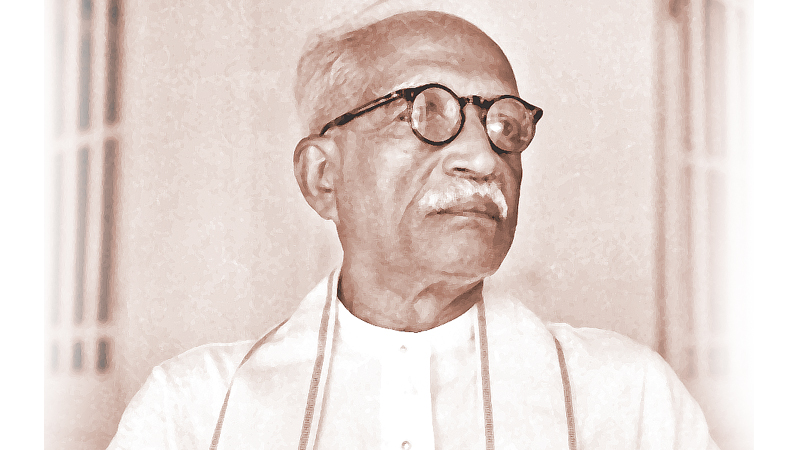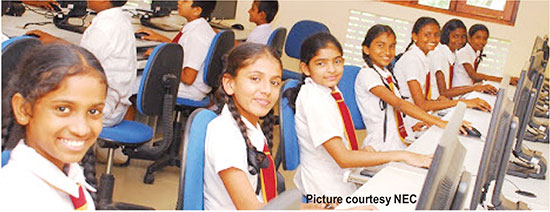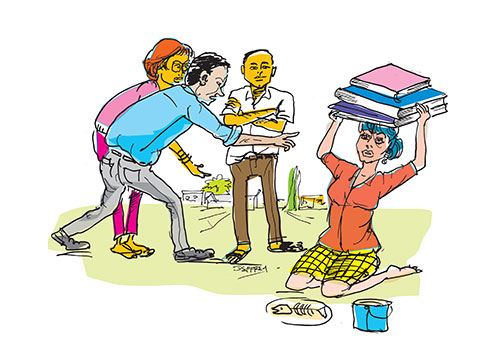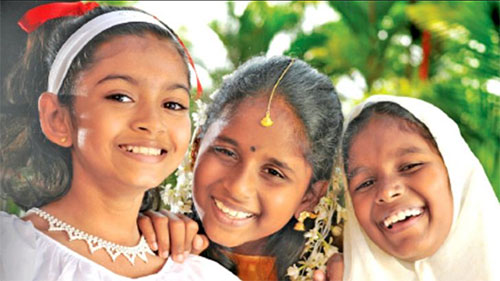“Wollstonecraft’s A Vindication of the Rights of Woman (1792) advocates for women’s empowerment through education, reflecting her fight against imposed stereotypes.”
by Aruni Samarakoon
In a recent Kuppi article by Nicola Perera, “Dealing with Sexual- and Gender-Based Violence (SGBV) in Universities” (18/02/2025), the author discusses the gap between institutional structures and the reality of preventing violence against women and marginalised communities, including the LGBTQ+ community, in Sri Lanka’s higher education sector.
Building on that discourse, this article focuses on highlighting the lack of integration of feminist pedagogy in Sri Lankan higher education. This gap may itself be a consequence of structural and institutional failures to recognise the nature of SGBV and implement effective preventive measures.
This article defines feminist pedagogy, explores its significance, examines its integration into education, and concludes with key insights.
What is Feminist Pedagogy?
A simple answer to this question is that feminist pedagogy is a method of reading the reality of the world, nurtured by an understanding of power dynamics that play a crucial role in interpreting that reality. These power dynamics determine who defines reality, what is considered knowledge, and how that knowledge is read and understood.
This fundamental understanding is further supported by scholars like bell hooks. In Teaching to Transgress (1994), she argues that when knowledge is reduced to mere information and does not connect to everyday struggles, it loses its transformative potential. Feminist pedagogy, however, opens knowledge to the real world by linking it to activism and the struggles of the powerless. This connection between knowledge and everyday struggle forms the foundation of how feminist pedagogy understands and interprets the reality of the world.
Looking at the history of feminist pedagogy, from Mary Wollstonecraft to contemporary scholars like Sheila Rowbotham and Angela Davis, a common theme emerges: identifying the reality of how women are stereotyped—how their imaginations, abilities, and skills are constrained, and how they are confined to culturally prescribed roles—is essential. Understanding these limitations through a critical lens advances knowledge and human thought, allowing women to achieve self-actualization by defining their own identities beyond imposed norms. This process ultimately leads to liberation, fostering empowerment by creating space for their voices to be heard. By understanding the power dynamics involved in shaping these realities, empowerment occurs. This empowerment enables individuals to make conscious choices and take action.
Scholars like Mary Wollstonecraft, bell hooks, Sheila Rowbotham, and Kumari Jayawardena have examined social realities of women’s inequality, exclusive education, revolutionary consciousness, limited social welfare, and class-ethnic discrimination, often connecting these issues to their own struggles or those of others.
Wollstonecraft’s A Vindication of the Rights of Woman (1792) advocates for women’s empowerment through education, reflecting her fight against imposed stereotypes. hooks’ scholarship addresses her experience as a Black, working-class woman, examining power dynamics in shaping human thought. Rowbotham, in Reasons to Rebel (2024), highlights women’s revolutionary consciousness in the UK, demanding state accountability for welfare. Jayawardena’s work underscores ongoing struggles of the working class, especially in plantation sectors.
The above examples of scholarship highlight that feminist pedagogy critically examines the given reality by questioning who, why, what, and how that reality has come into existence.
Why Feminist Pedagogy?
To answer this question, I take the liberty of drawing on Nicola’s discourse on SGBV in the higher education sector. She raised an important issue: although the legal and institutional structure to prevent SGBV are already in place—structures that extend from the local to the international level through universal charters—SGBV still persists within higher education institutions. This violence primarily affects women and communities such as LGBTQ+ individuals.
This issue is closely connected to feminist pedagogy, as it invites an epistemological examination of social realities, critically analysing the power dynamics that underpin these realities. As Nicola points out, questions arise about who holds the ultimate power to investigate SGBV, and who has the agency or voice to challenge it. These questions, in turn, reflect the power structures at play. It is widely recognized that women experience sexual and physical abuse at universities, yet only a few cases are reported. Many remain hidden because victims’ agency to speak out is constrained by the power structures surrounding them or the influence of their abusers—who often have direct or indirect ties to powerful institutional figures.
The political irony in this context is that, instead of empowering these marginalised individuals, their limited agency is often romanticised by some academics, sometimes through symbolic acts like composing songs. Today, abuse is not limited to women but extends to the LGBTQ+ community within universities. While LGBTQ+ identities are not legally recognised in Sri Lanka, contemporary political discourse has supported the recognition of their identity and the securing of their voice. Despite this, the Sri Lankan higher education sector continues to struggle with effectively identifying and preventing violence against them.
With feminist pedagogy, the struggles of women, men, and the LGBTQ+ community are recognised as essential players to the teaching and learning environment, pushing knowledge beyond the classroom and connecting it to the real world. This can be further explained through an example: How do we understand and recognise women in academia? Is she seen as an agent of academic and research progress, or is she reduced to a sexual object—someone who wears beautiful saris and dark red lipstick for the pleasure of men in academia? (I strongly believe that women should be free to wear whatever they like and use makeup as they choose.). In the case of academic women who are pregnant or raising young children, despite their medical conditions, their capacities and skills should not be undermined or viewed as fragile and in need of guidance, as this reinforces gender stereotypes. How do academic institutions perceive women? Are they expected to be ambitious, career-oriented, focused on self-actualization, and hold their academic views as a form of freedom of expression? Are Sri Lankan universities aware of women experiencing endometriosis or menopause, which can significantly affect their academic performance?
These critical readings and understandings are fostered through feminist pedagogy.
How to Integrate Feminist Pedagogy
It is important to note that the integration of feminist pedagogy and the assimilation of feminist pedagogy are two different scenarios. Currently, Sri Lankan academia follows the assimilation of feminist pedagogy approach. This assimilation is structured through the separation and isolation of the curriculum into gender studies. My argument is that gender studies and feminist pedagogy are two distinct curriculum areas. Almost every Faculty of Humanities and Social Sciences at Sri Lankan universities already offers courses in gender studies, which is impressive and significant in terms of raising awareness about gender definitions, inequalities, injustices, and research related to gender matters.
However, feminist pedagogy is still new to Sri Lanka and has not yet been integrated into the curriculum. This can be illustrated further through the study of International Relations within Political Science degrees. There is no feminist perspective included in the discussion of International Relations. Feminist approaches—such as idealist and realist feminist pedagogy—have yet to be incorporated into International Relations coursework in Political Science. In the case of Conflict and Peace Studies, the understanding of conflict history, including women’s roles in conflicts, is essential. For example, why did working-class Tamil women, at some point, decide to leave their homes and join a militant revolutionary movement? What does peace mean for women? How can we discover peace through feminist consciousness? These are some of the examples that reinforce my claim that feminist pedagogy must be integrated into Conflict and Peace Studies, rather than merely teaching John Galtung’s “Conflict Triangle.” The absence of a critical feminist examination of Galtung’s interpretation of conflict and peace further highlights the need for feminist pedagogy in this field.
In the field of STEM, feminist pedagogy can be integrated by highlighting women’s contributions to invention, understanding their methods of engaging with materials, and using empirical findings based on women’s narratives to strengthen research outcomes.
Conclusion
Throughout this article, the underlying point is that feminist pedagogy, integration of feminist pedagogy, rather than its separation and isolation within a specific curriculum like gender studies. Through this integration, feminist pedagogy can be recognized as an independent method of study that brings new perspectives, enabling a deeper understanding and analysis of social realities. it further leads to raise their voices against violence, to create a safe and secure higher education environment for everyone, to maintain their identities and become who they want to be, and to contribute collectively to the struggle for justice, equality, and the representation of diversity.
I do not romanticise feminist pedagogy; rather, I believe it fosters the development of human critical thinking and empowers individuals. This empowerment is not only for women but for men as well, because education, empowerment, and justice in scholarship and pedagogy benefit everyone. Meanwhile, I am deeply grateful to every woman who has fought, struggled, and achieved victories in their struggles, standing and continuing to stand for the rights of every living being on this planet. Wishing everyone a meaningful International Women’s Day 2025!



